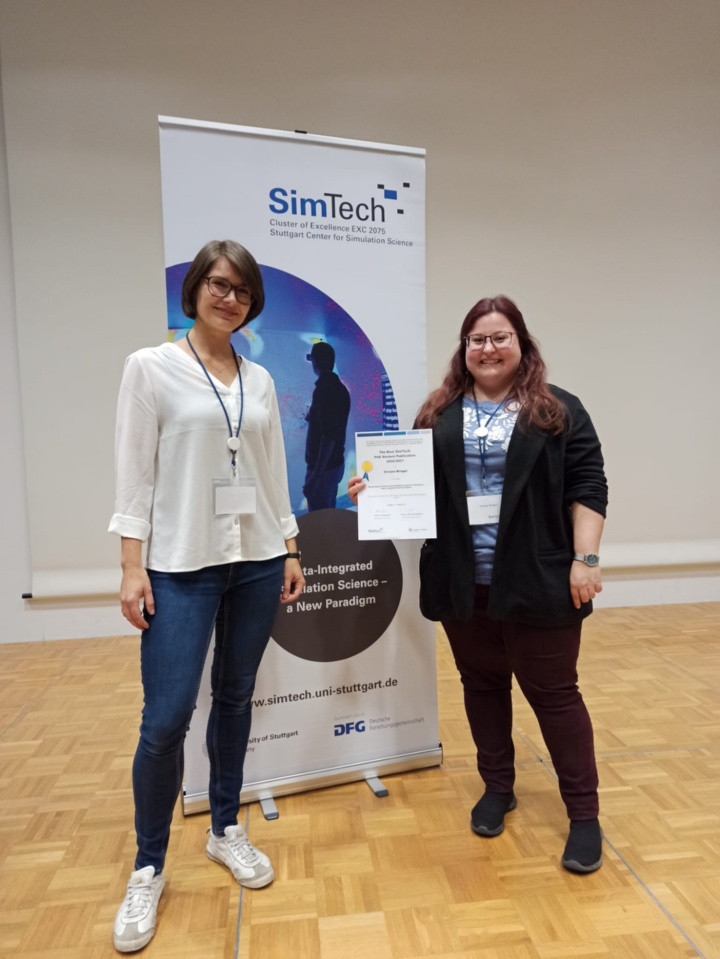During this year’s SimTech status seminar, Viviane Klingel and Samuel Tovey, PhD researchers of GS SimTech, were awarded the Best Paper Award. The prize is awarded by the Graduate School of the Stuttgart Center for Simulation Science, the Cluster of Excellence SimTech at the University of Stuttgart and the Industrial Consortium SimTech e. V. and is endowed with 250 EUR. In addition to the SimTech junior research group leaders Kristyna Pluhackova, Anneli Guthke, Paul-Christian Bürkner, Benjamin Unger and Alexander Schlaich, the jury also included the new SimTech professors Benedikt Ehinger, Marco Oesting and Benjamin Uekermann. The evaluation of the submissions included criteria such as the connection of the paper to SimTech’s visions, the nominee’s contribution to the paper as well as collaborations within SimTech and beyond. Under these aspects, two submissions were selected:
„Model-based robustness and bistability analysis for methylation-based, epigenetic memory systems“ (Viviane Klingel)
Viviane Klingel received the award for her paper “Model-based robustness and bistability analysis for methylation-based, epigenetic memory systems", which she published together with Jakob Kirch, Timo Ullrich, Sara Weirich, Albert Jeltsch and Nicole Radde. The paper is published in The FEBS Journal in March 2021 (Volume 288, Issue 19).
In their work, Viviane Klingel and the other authors have developed a mathematical model describing methylation-based epigenetic memory systems that operate in a bistable range and capture induced switching dynamics. The memory function is sensitive to parameter variations. Their model anticipates that a distributed cell division rate causes a bimodal response and population heterogeneity. Moreover, the memory function is highly sensitive to temperature. Predictions are confirmed with flow cytometry experiments.
Viviane Klingel is working on her PhD in the group of Nicole Radde on systems biology, which aims at describing biological processes mathematically. Her research is focused on modelling and analyzing an epigenetic memory system, which was and is being developed in the group of Albert Jeltsch. This highly collaborative project combines biological studies with mathematical modeling and systems theory to gain insights into the system and aid in improving it.
Abstract
In recent years, epigenetic memory systems have been developed based on DNA methylation and positive feedback systems. Achieving a robust design for these systems is generally a challenging and multifactorial task. We developed and validated a novel mathematical model to describe methylation-based epigenetic memory systems that capture switching dynamics of methylation levels and methyltransferase amounts induced by different inputs. A bifurcation analysis shows that the system operates in the bistable range, but in its current setup is not robust to changes in parameters. An expansion of the model captures heterogeneity of cell populations by accounting for distributed cell division rates. Simulations predict that the system is highly sensitive to variations in temperature, which affects cell division and the efficiency of the zinc finger repressor. A moderate decrease in temperature leads to a highly heterogeneous response to input signals and bistability on a single-cell level. The predictions of our model were confirmed by flow cytometry experiments conducted in this study. Overall, the results of our study give insights into the functional mechanisms of methylation-based memory systems and demonstrate that the switching dynamics can be highly sensitive to experimental conditions.
“DFT Accurate Interatomic Potential for Molten NaCl from Machine Learning“ (Samuel Tovey)
The second award winner is Samuel Tovey, who was recognized for his publication on "DFT Accurate Interatomic Potential for Molten NaCl from Machine Learning," which he co-published with Anand Narayanan Krishnamoorthy, Ganesh Sivaraman, Jicheng Guo, Chris Benmore, Andreas Heuer, and Christian Holm in the Journal of Physical Chemistry.
Samuel Tovey is a PhD student under Professor Holm at the institute for Computational Physics. His research is focused on better understanding the application of machine learning methods to the simulation of physical systems. This is largely focused on the optimized development of inter-atomic potentials for ionic systems. Beyond this work, he also studies how machine learning approaches may be used to extract information about symmetries present in raw data. This work is accompanied by extensive software development aimed to provide access to all of his research as well as a platform for future extension.
In the paper, the authors used a Gaussian process regression driven potential to study the impact of temperature on the structure and dynamics of molten sodium chloride. This project involved the development of ab-initio data through density functional theory simulations, construction and evaluation of the inter-atomic potential using an established Gaussian process regression code, the deployment of this potential in large-scale molecular dynamics simulations, and the post-processing of these simulations. They found that the machine learned potential was capable of retaining the accuracy of the ab-initio approach even when scaled to systems of 1000s of atoms and on nano-second time scales. To further validate the results of our simulations the authors compared them with experimental values and found excellent agreement.
Abstract
Molten alkali chloride salts are a critical component in concentrated solar power and nuclear applications. Despite their ubiquity, the extreme chemical reactivity of molten alkali chlorides at high temperatures has presented a significant challenge in characterizing atomic structures and dynamic properties experimentally. Here, we investigate molten NaCl by performing high-temperature molecular dynamics simulations using a Gaussian approximation potential (GAP) trained on density functional theory (DFT) data sets. Our GAP model, trained with 1000 atomic configurations, arrives near DFT accuracy with a mean absolute error of 1.5 meV/atom, thus enabling fast analysis of high-temperature salt properties at large length (5000 ion pairs) and time (>1 ns) scales, currently inaccessible to ab initio simulations. Calculated structure factors and diffusion constants from our GAP model simulations show excellent agreement with experiments. Our results indicate that GAP models are able to capture the many-body interactions required to accurately model ionic systems.
Congratulations to both of them!




